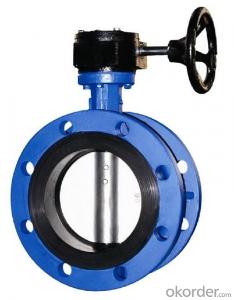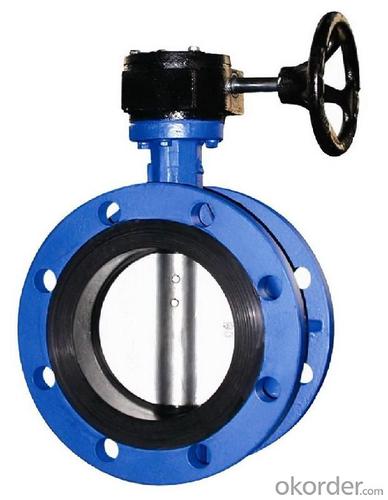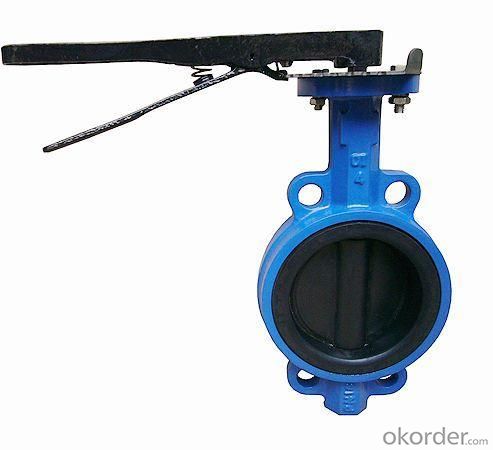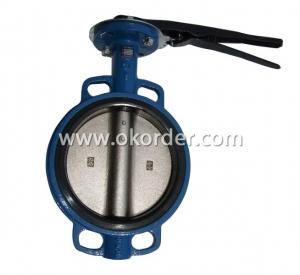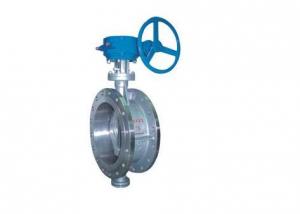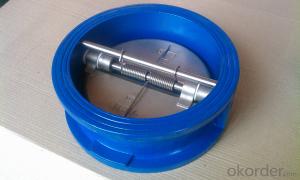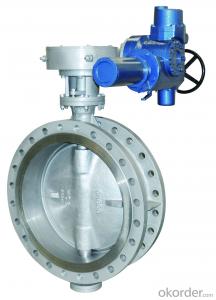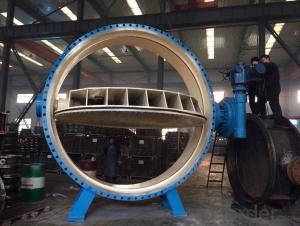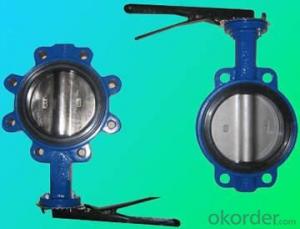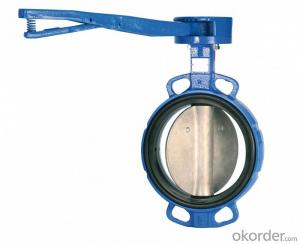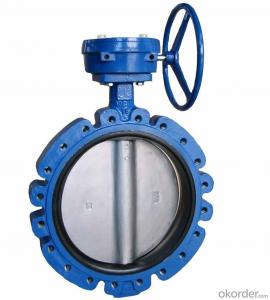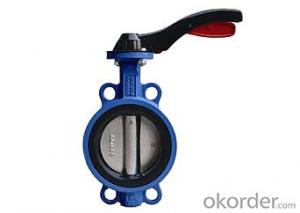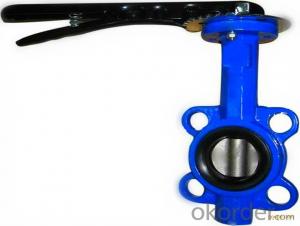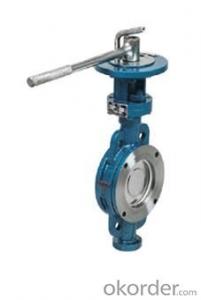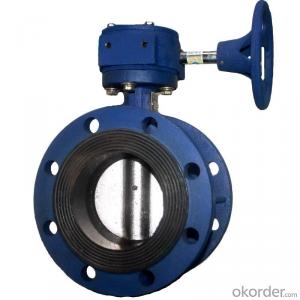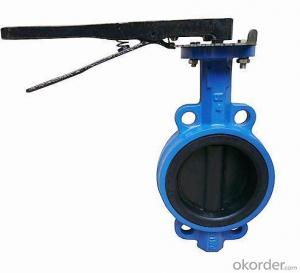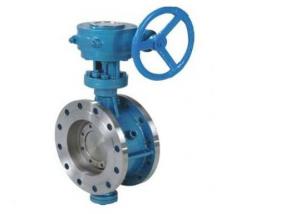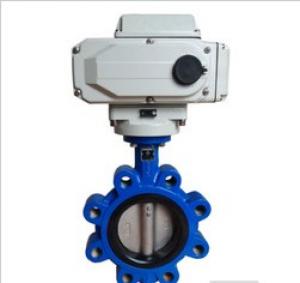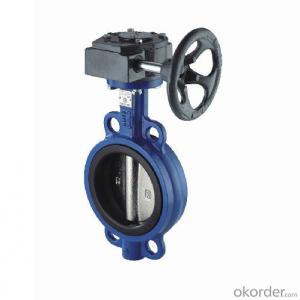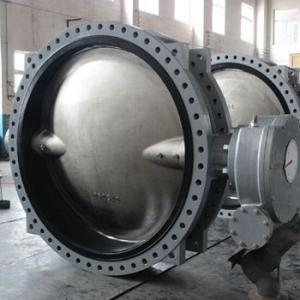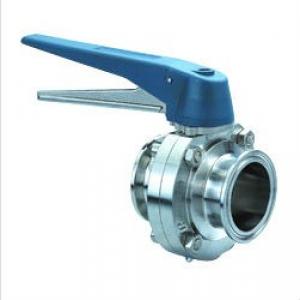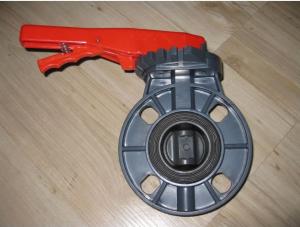Butterfly Valve Without Pin Ductile Iron DN270
- Loading Port:
- Tianjin
- Payment Terms:
- TT OR LC
- Min Order Qty:
- 50 set
- Supply Capability:
- 50000 set/month
OKorder Service Pledge
Quality Product, Order Online Tracking, Timely Delivery
OKorder Financial Service
Credit Rating, Credit Services, Credit Purchasing
You Might Also Like
Centerline structure,pinless double half shaft design.
Disc has two-way bearing, no installation direction requirements.
Non-backed replaceable seat with good performance and a longer working life.
Square and short neck for lable use and cost saving.
Easy installation, no need flange gasket.
| Size | DN50mm-DN600mm |
| Design standard | API609/EN593 |
| End flange | DINPN10/PN16, BS4504PN10/PN16, ANSI class125#/class150# |
| Face to face | API609/EN558-1 |
| Top flange | ISO5211 |
| Body | Ductile iron/Cast iron |
| Disc | Ductile iron/CF8/CF8M/C95400/C95500 |
| Stem | SS420 |
| Seat | EPDM/NBR/Viton/PTFE |
| Actuator | Bare shaft/Lever/Gearbox and handwheel |
| Coating | Epoxy/Nylon/PTFE |
| Pin | With out pin |
| Suitable medium | Water/Seawater/Sewage/Air/Foodstuff/Oil |
- Q: i have a slightly small mitral valve leak in my heart. my cardiologist say nothing to worry about, but i am not sure. can some one explain if it would eventually lead to some complications?
- I have Mitral Valve Prolapse, and slight regurgitation. If your cardiologist says not to worry, I wouldn't worry. Mitral Valve prolapse just means you have a slight deformity of the bicuspid valve. It doesn't close correctly. It's not a disease, or anything like that, just a slight deformity. The symptoms are annoying. You may or may not have palpitations, slight sharp chest pain sometimes, dizziness, fatigue, and anxiety from it. You must have it checked yearly to make sure it's not progressing. I have had it since I was born, and now I am 28, and it has not progressed at all. MILLIONS of people are walking around with it, and don't even know it. It's not really a big deal. However, it does have the potential to worsen and you may or may not need a new valve. But that normally happens when you're older, in your 50's or up. Don't worry about it.
- Q: Check valve; flexible joint `; installation order of electric butterfly valve
- It is better to make an elastic hanger.In order to prevent the generation of water hammer when the pump stops the damage to the rubber head, should be immediately set rubber head pump outlet, the gate valve and the check valve is not a very convincing reason to decide the order, custom order rubber head, check valve, electric butterfly valve.
- Q: Water supply pipe gate valve and butterfly valve which good?
- Butterfly valve is relatively applicable1 electric butterfly valve 0-90 degree rotation angle stroke valve, specific flow characteristics, small size, high performance price ratio2, electric valve up and down movement of the straight stroke control method, can be used as shut-off valve, large size, expensive3, electric butterfly valve can not be used for high temperature and high pressure conditions, not wear-resistant. Electric gate valve is generally used to close the material with a grain of material, suitable for high temperature and high pressure conditionsOur company specializes in the production of various types of valves, there is a need to help me, I would like to help
- Q: What are the classification criteria for pneumatic butterfly valves?
- The pneumatic clamp butterfly valve has a novel structure, and the structure of the valve body is short clamp structure for meeting the narrow space of the pipeline, and the outer zero leakage is in place, and the internal leakage conforms to the national standard.Pneumatic butterfly valve, connection flanges, the sealing clamp, lined with NBR, EPDM rubber, heat resistant ethylene propylene rubber, natural rubber, chloroprene rubber, fluorine rubber, PTFE, medium according to the chemical properties have a more rational choice.Pneumatic fluorine valve, corrosion fluorine valve using the bisection valve combination two, valve seat and valve liner valve work, integration, only full plastic seat and lining plastic disc contact with the media, the product can withstand any corrosion in molten alkali metal and fluorine elements ", which D71F46 stem and disc board (forging) as a whole, the surface is uniformly coated with a layer of FEP.
- Q: What are the butterfly valves models?
- Sealing surface material score:(1) soft sealing butterfly valve.1) the sealing pairs are made of non-metallic soft materials, which are made of non-metallic soft materials.2) the sealing pair is made of metal hard material and is made of non-metallic soft material.(2) metal hard sealing butterfly valve. The sealing pair is made of metal hard material and is made of metal hard material.According to the form of sealing:(1) forced sealing butterfly valve.1) elastic sealing butterfly valve. The pressure of the valve seat, seat, or plate is produced when the seal is closed by the pressure from the valve.2) additional torque seal butterfly valve. The seal is produced by a torque that is applied to the valve shaft.(2) pressure sealed butterfly valve. The pressure is greater than the pressure on the seat or plate.(3) automatic sealing butterfly valve. The pressure of the seal is automatically generated by the pressure of the medium.
- Q: Who can give me a download UG butterfly valve, needle valve, diaphragm valve standard model address, Japanese standard, American Standard.
- Support many 3D CAD format, such as the commonly used UG, Pro/E, SolidWorks......As for the butterfly you said, don't post the link up, the standard JIS, American Standard ANSI, German standard DIN are.You use Baidu Search "LinkAble PARTcommunity", after the open registration, CAD format, such as UG, ASAHI and then to find the manufacturer home page, which is the valve, you said the Japanese standard, German standard, American Standard valve basically all.
- Q: What is the butterfly valve
- Conclusion: Although the double valve advanced technology, metrology, but must ensure stable and timely flow of materials, in order to achieve good results, so the combination of flotation system and dual use of butterfly valve can fundamentally solve the flow and measurement of powder, so as to rely on self weight principle of materials, so we plant layout the middle of a large number of mechanical equipment to save not only, more important to reduce the cost of investment and running.
- Q: Butterfly valve D71X-1.6C, DN50, there is no difference between C and no C? What do you mean by "concrete"?
- The C indicates that the material is carbon steel and does not indicate cast iron (generally omitted)
- Q: DN80 flange butterfly valve, DN80 flange butterfly valve DN80, flange butterfly valve DN80 what is the difference?
- No, what's the difference?. It's not all the same.Flange connectionDN80 caliber butterfly valve. What's the difference?. Model and pressure. Materials are not ~!
- Q: What is the national standard for clip butterfly valves?
- GB/T 12238-2008 "flange and clip connection elastic seal butterfly valve"GB/T 26144-2010 flanged and clip on steel lined fluoroplastic butterfly valvesJB/T 8527-1997 "metal sealed butterfly valve"
Send your message to us
Butterfly Valve Without Pin Ductile Iron DN270
- Loading Port:
- Tianjin
- Payment Terms:
- TT OR LC
- Min Order Qty:
- 50 set
- Supply Capability:
- 50000 set/month
OKorder Service Pledge
Quality Product, Order Online Tracking, Timely Delivery
OKorder Financial Service
Credit Rating, Credit Services, Credit Purchasing
Similar products
Hot products
Hot Searches
Related keywords
